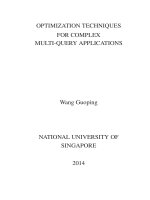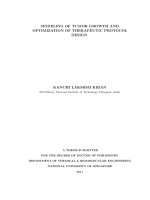Optimization Background for Network Design
Bạn đang xem bản rút gọn của tài liệu. Xem và tải ngay bản đầy đủ của tài liệu tại đây (279.63 KB, 7 trang )
<span class='text_page_counter'>(1)</span><div class='page_container' data-page=1>
<b>Optimization Background for </b>
<b>Optimization Background for </b>
<b>Network Design</b>
<b>Network Design</b>
<b>David Tipper</b>
<b>Associate Professor</b>
<b>Associate Professor</b>
Department of Information Science
and
Telecommunications
University of Pittsburgh
<b></b>
<b></b>
<b>Slides 5</b>
<b>Slides 5</b>
<b> />
<b> />
Network Design Tools
Network Design Tools
• Optimization formulation to try and minimize cost
– Metro and WANS Designed using computer aid tools
</div>
<span class='text_page_counter'>(2)</span><div class='page_container' data-page=2>
Telcom 2120 3
• Variety of tools available
– WANDL, VPISystems, OPNET, RSOFT, etc. – trend is to
develop tools for internal use only make money on consulting
Network Design Tools
Telcom 2110 Spring 2006 3
Optimization Review
• Optimization Techniques
– Seek to find maximum or minimum of a objective function
– Set of unknown decision variables
– Constraintslimit the possible values for the variables
• Definition
</div>
<span class='text_page_counter'>(3)</span><div class='page_container' data-page=3>
Telcom 2120 5
Types of Optimization Problems
Telcom 2110 Spring 2006 5
Simple Continuous Optimization
• If Unconstrained
– objective function F(X)is continuous function of xand
x is continuous
– Find MAX/MIN of F(x)by differentiation (set derivative = 0)
– Determine if MAX or MIN by second derivative
– If multi-dimensional – calculate gradient – use numerical gradient
search methods
– Newton's method gives rise to a wide and important class of
algorithms that require computation of the gradient vector
ˆ ˆ ˆ
( , , )<i>x y z</i> <i>x</i> <i>y</i> <i>z</i>
<i>x</i> <i>y</i> <i>z</i>
φ φ φ
φ ∂ ∂ ∂
∇ = + +
</div>
<span class='text_page_counter'>(4)</span><div class='page_container' data-page=4>
Telcom 2120 7
Constrained Optimization
Maximize (or minimize):
Subject to:
Constraints
Objective
• General Symbolic Model
…
(
<i>x</i> <i>x</i> <i>xn</i>)
<i>f</i> 1, 2K
( ) { }
( ) { }
1 1 2 1
2 1 2 2
, , ,
, , ,
<i>n</i>
<i>n</i>
<i>g</i> <i>x x</i> <i>x</i> <i>b</i>
<i>g</i> <i>x x</i> <i>x</i> <i>b</i>
≤ ≥ =
≤ ≥ =
K
K
( 1, 2 ) { , , }
<i>m</i> <i>n</i> <i>m</i>
<i>g</i> <i>x x</i><sub>K</sub><i>x</i> ≤ ≥ = <i>b</i>
… where <i>x</i>1,<i>x</i>2K<i>xn</i> are the <b>decision variables</b>
Telcom 2110 Spring 2006 7
Mathematical Programming
• Types of Mathematical Programs:
<b>– Linear Programs (LP):</b>the objective and constraint functions
are linear and the decision variables are continuous.
<b>– Integer (Linear) Programs (IP):</b>one or more of the
decision variables are restricted to integer values only and the
functions are linear.
• Pure IP: all decision variables are integer.
• Mixed IP (MIP): some decision variables are integer, others
are continuous.
</div>
<span class='text_page_counter'>(5)</span><div class='page_container' data-page=5>
Telcom 2120 9
Linear Programming
Maximize:
Subject to:
Constraints
Objective
Bounds
… where <i>a<sub>ij</sub></i>,<i>b<sub>j</sub></i>,<i>c<sub>j</sub></i> are the model parameters.
• General Symbolic Form
…
{ }
{ }
11 1 12 2 1 1
21 1 22 2 2 2
, ,
, ,
<i>n</i> <i>n</i>
<i>n</i> <i>n</i>
<i>a x</i> <i>a x</i> <i>a x</i> <i>b</i>
<i>a x</i> <i>a x</i> <i>a x</i> <i>b</i>
+ + + ≤ ≥ =
+ + + ≤ ≥ =
K
K
{ }
1 1 2 2 , ,
0 , 1, ,
<i>m</i> <i>m</i> <i>mn</i> <i>n</i> <i>m</i>
<i>j</i>
<i>a x</i> <i>a</i> <i>x</i> <i>a</i> <i>x</i> <i>b</i>
<i>x</i> <i>j</i> <i>n</i>
+ + + ≤ ≥ =
≤ =
K
K
<i>n</i>
<i>nx</i>
<i>c</i>
<i>x</i>
<i>c</i>
<i>x</i>
<i>c</i>1 1+ 2 2+<sub>K</sub>
<i>x</i>
<i>c</i>
<i>Maximize</i> <sub>:</sub> <i>T</i>
Telcom 2110 Spring 2006 9
Linear Programming
Maximize:
Subject to: Constraints
Objective
Bounds
• Can be written in matrix formulation
<i>x</i>
<i>c</i>
<i>T</i><i>b</i>
<i>Ax</i>
=
<i>j</i>
<i>x<sub>j</sub></i> ∀
≤
0
</div>
<span class='text_page_counter'>(6)</span><div class='page_container' data-page=6>
Telcom 2120 49
What are the remaining constraints ? :
- for link 3-5 ... ?:
- for link 4-5 ... ?
1
5
2
4
3
1
5
2 <sub>4</sub>
3
f2
f3
f4
10
20
20
5
8
20 10
20
5
8
2 2
c5: f3 + f2 <= 20; /*link 35 capacity */
c6: f4 + f1 <= 5; /*link 45 capacity */
f1
(note this makes prior
constraint f4 + f1<=10
redundant )
Network Flow LP Formulations (8)
“flow assignment to routes” or “arc-path” approach - example (2)
Source: W. D. Grover, ECE 681, UofA, Fall 2004
• Note that the “indicator” parameters do not appear explicitly in the
executable model.
• Really they just represent our knowledge of the topology and the routes
being considered.
• Implicitly above, we only wrote the flow variables that had non-zero
coefficients.
Examples:
<i>k</i>
<i>i</i>
δ
12
1 (flow1 crosses span 12)
1
δ =
35 <sub>1 (flow3 crosses span 35)</sub>
3
δ =
Hence f1 is in the first constraint
Hence f3 is in the fifth constraint, etc.
Network Flow LP Formulations (9)
</div>
<span class='text_page_counter'>(7)</span><div class='page_container' data-page=7>
Telcom 2120 51
Sonet/STM Design Problem
Complexity - Solving Design Problems
• Real world Network Design problems are quite large (have many variables and
constraints)
– Graph Theory and Optimization Based algorithms for network design are complex
– when can one use a technique?
• Complexity of an algorithm usually denotes O(.) which denotes the order of
time growth in the algorithm as a function of problem variables
– Dijkstra’s Algorithm for SPT O(N2<sub>) where N is number of nodes in graph</sub>
– Prim’s Algorithm for MST O(E log(N)) where N is # nodes, E # edges
• Problems that can be solved by a deterministic algorithm in a polynomial time
complexity denoted P that is O(Nk<sub>) </sub>
• Problems that can not be solved with P complexity denoted NP and don’t scale
well
– Linear Programming Problems have P complexity
– Integer Programming Problems have NP complexity
• Still Branch and Bound can be used for small problems !
• In general for NP problems use Sub-optimal algorithms (meta-heuristics)
</div>
<!--links-->

![the web designer's roadmap[electronic resource] your creative process for web design success](https://media.store123doc.com/images/document/14/y/cs/medium_csg1401384097.jpg)

![google sketchup for game design [electronic resource] beginner's guide create 3d game worlds complete with textures, levels, and props](https://media.store123doc.com/images/document/14/y/wr/medium_wrx1401471786.jpg)





